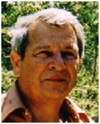What is Earth Day?
Earth Day and Agenda 21
We all feel a need to belong. Your family is important to you and you to them. We also like to be appreciated by peers, to contribute work and ideas to groups of people, and generally to be considered helpful and caring.
Perhaps our most important need is to be connected to nature
Perhaps our most important need is to be connected to nature. The city dwellers’ occasional excursions to the country side (weather permitting), adorned with the latest high tech garments and gadgets prove their point. The crops have been planted and are growing, the trees are sprouting new leaves and everything looks just fine. Their green vision is justified and duly reinforced.
Notwithstanding some unsightly and non-energy-producing wind turbines among the farm fields, the country folks may need some further improvements, more green ideas pressed upon them. After all, such are strictly for the common good. How about bicycling to the corner store, or subscribing to a glossy magazine extolling the virtue of multi-million dollar, interior-designer enhanced modern architecture in a perfect landscape setting? (No windmills to be found in those magazines). Now that’s what country life is really all about!
There is a widening disconnect between city and country dwellers
There is a widening disconnect between city and country dwellers. Urbanites crave for the lacking connection to nature and small farm owners can barely survive working their land. Some work two jobs, one on the farm and another in town.
This disconnect also is apparent from the political preferences. For example, in the last federal election, most electoral ridings in the large urban areas of Toronto, Windsor and Hamilton (combined population of approximately 6 million) mostly went to “progressive” (liberal-minded) candidates, while those in the rest of the province went primarily to conservative candidates. The same kind of generalization applies to other parts of North America.
Why Earth Day?
Why Earth Day? The country folks have their traditional festivals and entertainments. The city dwellers can go for their lattes and concerts most anytime. So, how did Earth Day come about and what does it mean?
Officially, Earth Day, correctly termed “International Mother Earth Day” was established in 2009 by the UN’s General Assembly under Resolution A/RES/63/278 and the “International Mother Earth Day promotes a view of the Earth as the entity that sustains all living things found in nature. Inclusiveness is at the heart of International Mother Earth Day; fostering shared responsibilities to rebuild our troubled relationship with nature is a cause that is uniting people around the world.” (Wikipedia)
The true origins of Earth Day date much further back in history, perhaps to the flower children generation of the 1960s. At the 1969 counterculture music festival at Woodstock, near Bethel, NY, some 500,000 city dwellers congregated for a three-day event. It was a giant love-in of music and “nature.”
From DDT to Climate Change
Beginning with the 1990s, the environmental scares of the 1960s (such as the insecticide DDT for which Paul Müller was awarded a Nobel Prize some decades earlier) had lost their momentum. A new, if possible even bigger threat to Mother Earth was urgently needed. Global warming and carbon dioxide (CO2) fit the bill just fine. This novel direction also had the backing of new political movements, such as the Green Party in Germany, and other groups which hoped to capitalize on this idea. They were pushing for a climate control agenda. Al Gore’s imaginations, dishonest climate researchers with faulty computer models and billions of dollars in research funds did the rest. By 2007, the Woodstock festival had finally morphed into the new world scare of climate change. Gore and the IPCC shared a Nobel Prize that year, but their scare is losing momentum rapidly too.
Agenda 21
Now, the UN has found a new goal in Agenda 21 with its symbolic Mother Earth Day (MED), set for April 22nd. While nature slowly re-awakens from its winter slumber, the MED will mostly be celebrated by the flower children left over from the sixties and by the new socialistic-inclined cadre of Agenda 21 proponents. Agenda 21 intends to de-carbonize and to de-industrialize the world to conditions prevailing in the 1800’s, preferably under an UN mandate of world governance. The numerous Agenda 21 goals include the elimination of individuals’ right to property.
April 22nd also happens to be Vladimir Lenin’s birthday - perhaps not coincidentally - as noted by Alan Caruba in a recent post. Comrade’s Lenin promise of "Peace, Bread, and Land" was the initial stage of the collectivization of agriculture as later finalized by Josef Stalin. A more recent example of the collectivization of agriculture was under Robert Mugabe in Zimbabwe. Like under Stalin’s regime, thousands of people were tortured and murdered in Zimbabwe too; many others died from disease and famine. Prior to Mugabe’s rise to dictatorial power, Rhodesia (as Zimbabwe was known then) was viewed as the “Switzerland of Africa”, well run and prospering.
In January of this year, the Republican National Convention approved a resolution which asserts that Agenda 21 "is a comprehensive plan of extreme environmentalism, social engineering, and global political control.”
If your urge to re-connect with nature overcomes your objections to Agenda 21, you might use Earth Day to visit the countryside and tell the farmers how much you would like to trade your cushy city job for theirs, or that their land should be collectivized.
[1] [url=http://www.eco-imperialism.com/Waite%20-%20Facts%20about%20DDT.pdf]http://www.eco-imperialism.com/Waite%20-%20Facts%20about%20DDT.pdf[/url]
Dr. Klaus L.E. Kaiser -- Bio and
Archives |
Comments
Dr. Klaus L.E. Kaiser is author of CONVENIENT MYTHS, the green revolution – perceptions, politics, and facts Convenient Myths
